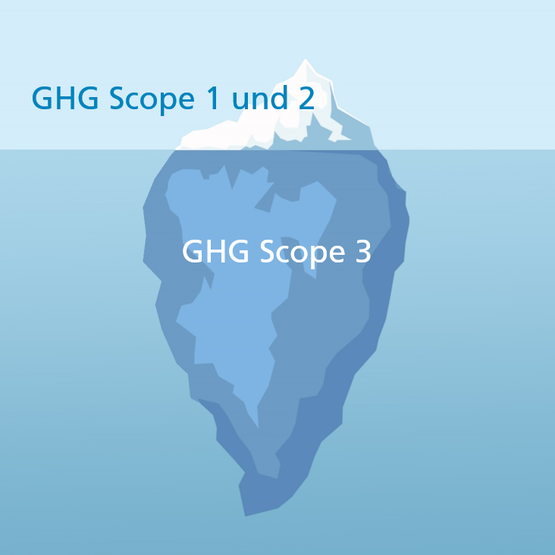Overview in 6 steps: How do I become climate neutral?
Balance sheet framework and factors
You define your accounting framework according to the type of carbon footprint: Corporate Carbon Footprint (entire organization), Product Carbon Footprint (value chain of a product) or Project Carbon Footprint (project-related emissions). You determine the emission factors for your set framework.
Climate strategy
A climate strategy for achieving climate neutrality is anchored in corporate policy. You set measurable climate targets, linked to a time period and compared to a base year. Specific GHG reduction initiatives should be identifiable.
Evaluate and weight
Which emission factors are particularly important in the carbon footprint balance sheet? Where can emissions be reduced or avoided? Naturally, it is advisable to look for optimization potential in the most important emission sources.
Compensate
Unavoidable greenhouse gas emissions are compensated by investments in environmentally relevant projects. These are possible worldwide, e.g., via international standards such as the Clean Development Mechanism (CDM), Gold Standard or Verified Carbon Standard (VCS).
Verify
Your data and calculations as well as your measures are checked by an independent body – based on documents and on site. If deficiencies are identified and demonstrably remedied, you will receive a certificate of your climate neutrality.
Publish
You have taken a step in the right direction. Now you can communicate what you have achieved: Publish your efforts and actions in a report and strengthen the trust of your customers and society in your company.
Three scopes: Which emissions should be included?

Scope 1: Direct emissions
Treibhausgase, die in der Organisation emittiert werden. Dies geschieht meist durch fossile Brennstoffe (Kohle, Gas, Öl), Kühlmittellecks, chemische Prozesse oder den eigenen Fuhrpark.
Scope 2: Indirect emissions
Emissions that are generated elsewhere and imported via energies and operating resources such as electricity, heat, compressed air, or cooling. Averaged emission factors may be used here.
Scope 3: Other indirect emissions
GHGs that occur outside the corporate boundaries and outside of Scope 2. There are 15 categories that include upstream and downstream aspects such as business travel, waste disposal and transportation (FAQ).
Three types of carbon footprints
You deal with direct and indirect impacts your work has on the environment, and that's good! Whether Corporate Carbon Footprint (CCF), Product Carbon Footprint (PCF) or even Carbon Footprint for individual projects: With a functioning climate strategy and an independently verified GHG balance, you help to preserve the basis of life for future generations and create trust.
Corporate Carbon Footprint

What does the CCF include?
The carbon footprint for companies (CCF) is made up of direct and indirect emissions of the entire organization: Directly in the company, at a site or at a part of the company.
Direct emissions
These include, for example, emissions from the company's own power plant or vehicle fleet, but also those emissions caused by industrial processes (for example cement or lime production).
Indirect emissions
Indirect emissions outside the company boundaries include, for example, employee and customer travel and transportation.
Product Carbon Footprint

What does the PCF include?
The carbon footprint for products (PCF) comprises the greenhouse gases along the value chain of a functional unit - such as a milk carton, a chocolate bar or a car.
Value chain
The chain begins with the extraction of raw materials and continues through production and distribution to utilization and recovery (recycling).
Emissions
All direct and indirect GHGs (3 scopes) of individual process steps are relevant - including intermediate inputs such as gasoline production or milk transport.
Project Carbon Footprint

What does CF mean for projects?
At project level, direct greenhouse gases and significant influencing factors are determined with and without savings measure ("before / after"). A project is a measure for which the savings are calculated.
What can it be?
It can be technical or organizational changes to increase efficiency, such as replacing a pump. Offset projects in developing countries are also possible.
Methodology
Standard GHG accounting criteria apply. Offset projects must meet strict criteria, such as financial additionality, permanence, and avoidance of double counting.
Frequently asked questions about climate neutrality
Which greenhouse gases must be considered? What do upstream chains and CO2e mean?
According to ISO 14064, the organization must report amounts of direct GHG emissions separately by type of gas in tons of CO2e. Relevant gases are CO2 (carbon dioxide), CH4 (methane), N2O (nitrous oxide), NF3 (nitrogen trifluoride), SF6 (sulfur hexafluoride), and other appropriate GHG groups such as HFCs (hydrofluorocarbons), PFCs (perfluorocarbons), etc. The CO2 equivalent CO2e indicates the GHG potential, i.e. how much a GHG contributes to global warming compared to the same mass of CO2.
Emission factors used to calculate carbon footprint are available without and, in the best case, with “upstream chains”. With upstream chains means that they include emissions from upstream and downstream processes. For example, the emission factor for diesel without upstream chain only includes direct emissions from its combustion. The emission factor with upstream chain additionally includes emissions that occur during extraction of raw material, refining, and through supply.
What are indirect greenhouse gas emissions (Scope 3) and which ones need to be considered?
Scope 3 emissions are a consequence of the company's activities along the value chain. However, they arise from sources not owned or controlled by the company. In the GHG Protocol these activities are divided into upstream and downstream processes and comprise 15 categories:
- Upstream: Purchased goods and services, capital equipment, fuel and energy-related activities (not Scope 1 or 2), upstream transportation and distribution, waste generated in operations/processes, business travel, commuting, upstream leased assets
- Downstream: Downstream transportation and distribution, Processing and use of sold products, End-of-life treatment of sold products (disposal/recycling), downstream leased assets, concessions, investments
Scope 1 and 2 emissions must be determined in accordance with ISO 14064-1 and GHG. Scope 3 emissions must be assessed and considered in terms of their materiality. According to PAS 2060, all greenhouse gases must be included and converted into t CO2e. This applies to 100% of all scope 1 and 2 emissions. Scope 3 emissions that account for more than 1% of the total of emissions must also be reported. If emissions have to be estimated, the occurrence of underestimations must be eliminated. The carbon footprint must include at least 95% of all emissions.
What are the benefits of creating and verifying a GHG inventory?
A carbon footprint serves as a management tool for implementing reduction plans regarding CO2 and expenses as well as for developing a clear climate strategy to help mitigate global warming.
External verification of the GHG footprint safeguards reporting, enhances reputation, and serves as evidence of the credibility of your carbon neutrality.
Which industries are particularly affected?
Responsibility for environmental protection affects all industries. Emission-intensive sectors such as energy production or heavy industry (steel, aluminium, etc.) naturally play a unique role. For this reason, concrete measures have already been defined in the climate package. The focus is also on companies whose products are delivered directly to end consumers (B2C), e.g. food or car manufacturers and public sector.
Food industry and retail in particular are taking an increasingly proactive approach to the issue of greenhouse gas accounting and climate neutrality: In the B2B sector, it is playing an increasingly important role in contract awarding; in the B2C sector, too, as it can influence corporate image, sales figures and thus market shares.
What does climate neutrality mean? What is the difference between being CO2 neutral and climate neutral?
Climate neutrality is the balanced state of carbon emissions and their absorption from the atmosphere in so-called carbon sinks. This means that no more greenhouse gases are emitted than those that can be absorbed by nature or other sinks.
However, in addition to greenhouse gases, other indicators may also play a role in global warming, such as soil and water contamination, raw material consumption and biodiversity. Looking at all environmental impacts is essential, but it is also very complex and requires a lot of effort. Therefore, the initial focus, aligned with the United Nations Framework Convention on Climate Change, is on the first step towards climate neutrality: Greenhouse gases (CO2 neutrality). However, to create binding definitions and statements on climate neutrality, the ISO 14068 standard is currently being developed at international level - until now, climate neutrality has usually been assessed using PAS 2060.
Where can I get reliable emission factors?
When selecting emission factors and databases, it should be noted that some factors include upstream chains and thus the production process (extraction, processing and transport, in some cases even proportionately the construction of conveyor plants). Others only take direct substance combustion into account. Some common databases are listed below: (excerpt):
- GEMIS (free of charge, values for energy, material and transport systems)
- ecoinvent (fee required, one of the most popular services)
- ProBas (free, with life cycle data, from UBA and Öko-Institut)
- EFDB fee required, English, contains emission factors of the Intergovernmental Panel on Climate Change (IPCC))
- Emission Factor Database (free, English, various sources)
- Greenhouse Gas Protocol (free, English)
- DBEIS ex-DEFRA; free, English, some data UK-specific)
- VDA (free of charge)
Calculation tools:
Which electricity mix do I have to use? What is a residual mix?
An emission factor for electricity is intended to reflect emissions caused by electricity consumption. Balanced emissions of consumed electricity usually differ from those generated during production. As stated in §42 EnWG, every electricity supplier has a so-called electricity labelling obligation, according to which environmental impact must also be shown in g CO2/kWh. The "residual mix" adjusts the production mix in a way that the emissions of imported and exported electricity volumes are included in the balance sheet and thus the certificates of origin are taken into account. Further information on the residual mix can be found at the association of issuing bodies (AIB).
What is a carbon handprint?
A carbon handprint calculates positive greenhouse gas impacts achieved through an active improvement compared to a given baseline. This can be achieved, for example, by remodelling a customer's performance.
This concept may be used for marketing and communication purposes - you can communicate your latest improvement or highlight climate benefits of your products and services.
What causes global warming?
Climate change is brought about by the greenhouse effect: Greenhouse gases in the Earth's atmosphere allow solar heat to enter the it, but hinder its radiation back into space. Many of these gases are natural components of the Earth's atmosphere. However, human activity has greatly increased the concentration of some greenhouse gases. CO2 is the most important greenhouse gas produced by humanity in terms of quantity: 63% of global warming caused by mankind is attributed to CO2.
Today, the concentration of CO2 in the atmosphere is 40% higher than at the beginning of industrialization. In smaller quantities, also other greenhouse gases are emitted, but they hinder the radiation of solar heat back into the universe a thousand times more effectively than CO2 does. 19% of man-made global warming is due to the greenhouse gas methane (CH4), 6% to nitrous oxide (N2O). Fluorinated gases account for most of the rest. The amount of greenhouse gases naturally occurring in the atmosphere is increasing enormously, mainly due to the use of fossil fuels, deforestation of rainforests and livestock farming.
Why is climate change a serious problem?
Rising temperature averages and steadily increasing sea levels are just two of many impacts of climate change. It also leads to a change in climate variability – such as strong short-term climate fluctuations and more frequent extreme weather events such as heavy rainfall or hot summers.
Reduced quality and quantity of drinking water and food are particularly threatening risks. Changed or prolonged occurrence of biological allergens (e.g. pollen) and increased appearances of so-called vectors (disease vectors such as ticks or mosquitoes) are also cause for concern. The shifting of fertile periods during which plants grow, flower and bear fruit also has an impact on agricultural production.
Economy and traffic are also affected: Roads and railways are washed out by heavy rain and suffer from high temperatures; inland waterways suffer from high or low water. In addition, many power plants draw their cooling water from rivers and feed it back in heated. If river water is too warm or severely depleted by summer heat, power plants may even have to be shut down.









